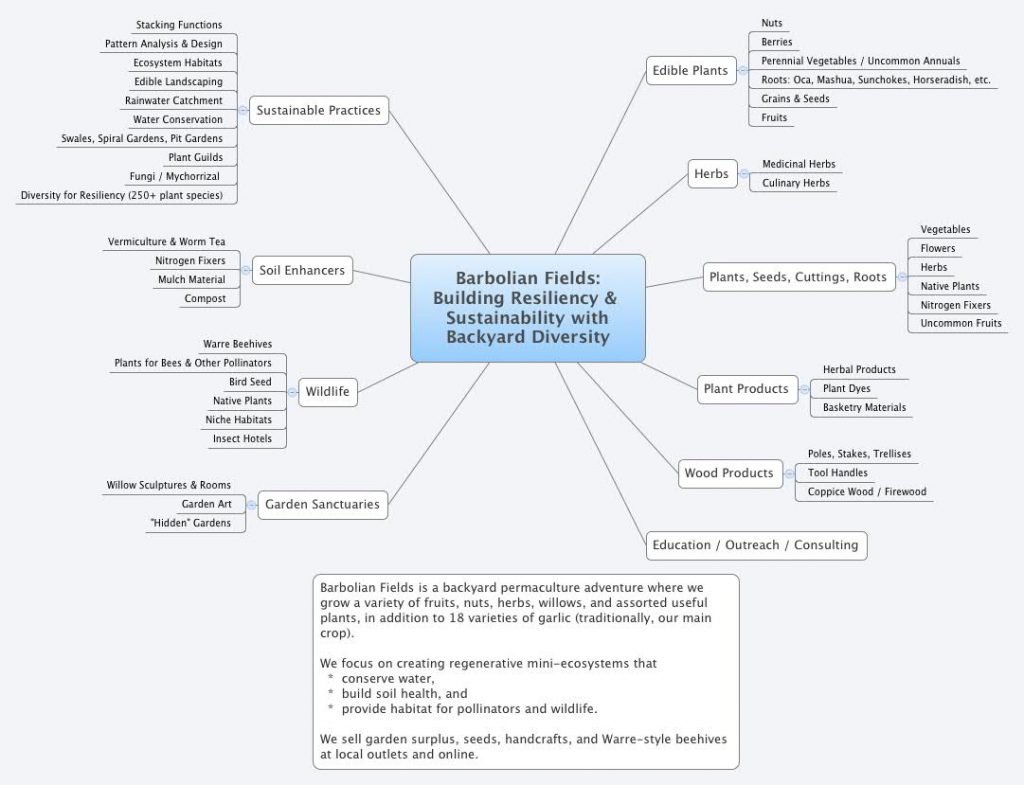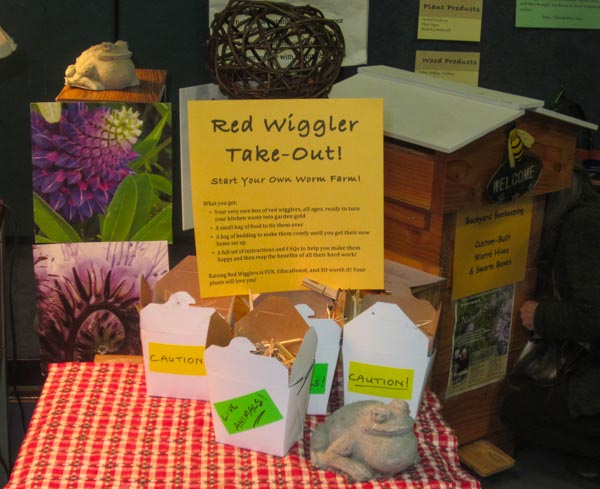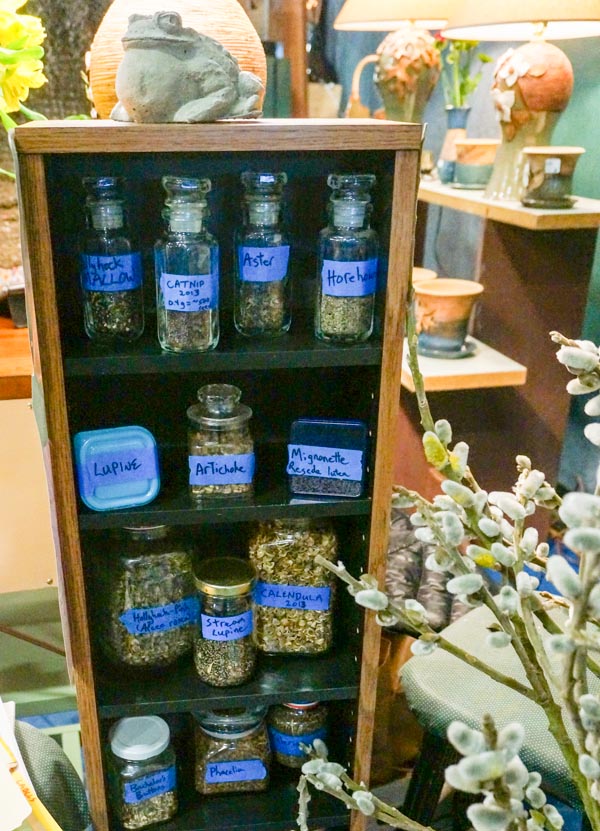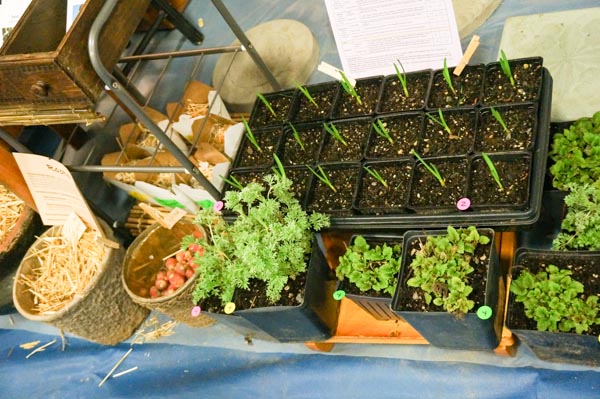I’d like to share a little identity crisis I went through recently that ended up being quite useful.
It started in mid-January when I signed up for a booth of my very own at the Soroptimist Gala Garden Event. It was the first time I had ever done such a thing, and it was one of those after-the-fact flashes: “OMG – what have I done?” Nothing like laying out cold hard cash to make you feel committed!
I have a great appreciation for those who set up booths at fairs and local markets to promote their wares and services – but until you actually do it yourself, it’s hard to fully comprehend all that goes into it. Not only are there issues of signage, displays (which is huge!), and countless details, but you also have to be very clear on what you are selling. That seems like a no-brainer, but hear me out. Your booth presents an identity, representing the character you are (and we are definitely a bunch of characters around here!).
For me, it was a “Who-am-I?” moment.
It seems almost humorous now that I could wonder how I could possibly fill up an 8’x10’ space, but I seriously questioned, “What have I got to sell?” After all, it wasn’t garlic season, and garlic has been my public identity for quite some time. But Barbolian Fields has evolved over the past few years to be much more than 2 dozen varieties of garlic, even though to some, that still seems like a lot.
“Much more” can also be defined as “all over the place.”
My business head tells me a niche enterprise is more likely to succeed. After all, my reputation as “the garlic lady” has been honed over many years of epicurean extravaganzas. A niche helps you build a brand. Next thing you know, everyone thinks you’re an expert. (Ha! That’s the Internet for you!)
But let’s reel this back to earth: strong ecosystems are not characterized by monocrops. By eco standards, diversity builds resiliency. Diversity weathers the volatility of, well, weather, for one, as well as trends and changing needs. Resilience and self-reliance are closely connected; our country was built on the strength of these values (and a certain amount of hard work and tenacity). Although our challenges may be quite different than those of our forefathers, they are also the same. We still need to be prepared for winter, weather abnormalities, including drought or floods, earthquakes or other disasters, family crises, health issues or injuries, financial insecurities, and anything that affects our ability to get food, water, and shelter.
I am not an extreme prepper-type; I don’t try to camouflage our garden (it hides itself on its own behind tall grasses, thank you!); but I do agree, we live in a tumultuous world. The news is full of political instability. Closer to home, we have just emerged from the wettest March on record, and the recent mudslide in Oso, WA, is a tragic tale of a ground that gave way under so much water. Our lives can change in an instant. I like the security of knowing we can take care of ourselves and help our family and community if the need arises. To me, building diversity helps us to face adversity.
Hmmm. My plant database is up to about 300 plant varieties; by that yardstick, I think we are on track.
(Some might still say, “All over the place.”)
But back to the question at hand – because what started this conversation was the need to pull together a booth at the upcoming garden show.
Again: “What are you selling?” (and by the same token, “Who, exactly, is going to buy it?”)
These are valid questions. You could be selling stuff – creative & cool and quite possibly useful, but still stuff – it could be plants (stuff category) – it could be services. Maybe even ideas. Knowledge.
I recognized I needed to get focused. I would be standing next to people who had been marketing their wares for years in brick-and-mortar establishments, or at the very least, well-seasoned at the farmer’s market and craft fair circuits. I needed something cohesive to pull together all the moving parts.
The sign that used to hang on my shop door that read, “House of Miscellaneous” simply wasn’t going to cut it.
I needed a theme.
Now I have been through the theme idea before, and it has fluctuated wildly over the years, but I still think the exercise is a valuable one, especially if you’re trying to make money at your gardening enterprise. I read the debates on whether it is possible to actually make a living with a permaculture-type garden – or whether an organic garden grown by more conventional methods is a more profitable way to go. In my opinion, defining the mission/vision/goals helps the hocus-focus either way.
So tell me: Can you define who you are, what you do, and what you can offer in 24 words or less? (ok, give yourself a few extra words; I certainly did!)
I began by throwing out some ideas in the form of a mind map (I used X-mind, because I like being able to move ideas around, and it’s free software – but certainly good ol’ paper & crayon would work as well). Ideas fell into several categories: Sustainable Practices; Soil Enhancers; Edible Plants; Herbs; Fresh Plants; Roots and Seeds; Plants for Wildlife & Pollinators; Plant Products; Wood Products; Garden Sanctuaries; Education / Outreach / Consulting. (Agreed, the categories overlap.)
Then I summarized it into a concept:
Barbolian Fields is a backyard permaculture adventure where we grow a variety of fruits, nuts, herbs, willows, and assorted useful plants, in addition to 18 varieties of garlic (traditionally, our main crop).
We focus on creating regenerative mini-ecosystems that
- conserve water,
- build soil health, and
- provide habitat for pollinators and wildlife.
We sell garden surplus, seeds, handcrafts, and Warré-style beehives at local outlets and online.
I honed the theme down even further and put it in the Center Focus box: Barbolian Fields: Building Resiliency & Sustainability with Backyard Diversity.
The final mind-map looked like this:
ALL THIS from a backyard garden less than an acre in size! (with room to grow!)
So – What did we display at the event?
- Beehives: A brand new Warré hive and swarm box on display (thank you, Jeff!)
- Soil Enhancers: LIVE Red Wigglers, in their own little take-out boxes, complete with instructions (these were a big hit!)
- Fresh Plants: garlic starts, assorted herbs, flowers, including flowers and pussy willows from Annie’s Flower Farm (thank you, Sid!)
- Roots: Oca from the Andes and a couple of uncommon varieties of sunchokes – definitely a curiosity!
- Seeds: Asters to Zinnias! And garlic bulbils, too!
- Dried Basketry Willows: several varieties in multiple colors! Oooh!
- Garden Crafts: Willow balls – kind of crazy & fun; woodburned bird feeders and garden stakes
- Personal Care Products using Dried Herbs: Soaps, Calendula Oil, DIY salve kits, bath herbs, sleep pillows, catnip toys, flea-repellant pillows – and individual dried herbs for teas
- Dye Plants: Madder, weld, and a host of others – plus two hand-knit bags dyed with madder and osage orange
- Up-cycled Products: Shopping bags made from seed sacks (thank you, Janet!)
- Stepping stones / garden pavers by Lone Stone (thank you, Mya – these were awesome and really set off the booth!)
- Free Information on permaculture, bees, and all the many things you can grow and make from your own backyard.
Wow. All THAT in an 8’x10’ space!!! And to think I wasn’t sure I’d have anything!
And How Did it Go? Very well, thank you! I met a LOT of great people, had a good return in sales, and had a great time!
What did I learn? A lot about what it takes to do such a thing! Also a lot about purchasing psychology. It will be much easier next year if I decide to do it. Changes? Always! Admittedly, the booth was far too cluttered. I would reduce the number of things to increase the visual impact of the best of what we have, with information on where to go for more. And I would go through the identity exercise again to reflect evolutions (or because I thrive on introspection and personal turmoil).
But the feedback, for me, was perhaps the most important. People were, frankly, amazed. ALL THIS from a backyard.
Food – medicine – fiber – dye plants – firewood – tools – support for wildlife, and most prominently, pollinators – living space – and everything fitting together to be a part of something much bigger than the thing itself.
We are all part of this net.
Granted, I am not a Ben Falk or a Carol Deppe. I am just your average person with a rather large garden that over the years has grown into something much more than anything I could have envisioned when I first stuck a clove of garlic in the ground some 35-plus years ago.
In the words of Albert Einstein (and who are we to question Einstein?): “I have no special talent. I am only passionately curious.”
I feel like I am just beginning. Why create a garden when you can create an entire ecosystem?
It’s not about the niche – it’s about the complete whole. That is the way nature works. That is the way we can be most resilient. The rewards are abundant.
Barbolian Fields: Building Resiliency & Sustainability with Backyard Diversity.
Yep. That’s who we are and what we do, alright. I like it. It’s strong. Resilient. All over the place.
~*~
Some pics from the show:

(photo by the Soroptimists of Sequim)
~*~
You Might Also Like:
Blogposts about the evolution of the garden and identifying themes and goals (or not):
Themes and Resolutions
Self-Imposed Limitations, Sustainability, and Creatively Breaking Rules
Reflections, Resolutions, and to All a Good Night
Food Forest Solution to a Boring Garden
Garden Resolutions, Goals, and To-Dos for 2013
What Worked – or NOT – in the 2013 Garden
Good Books:
“The Resilient Farm and Homestead” by Ben Falk
“The Resilient Gardener” by Carol Deppe
Also: a book that helped me a LOT on permaculture ideas (also available at our local library):
“Gaia’s Garden” by Toby Hemenway




